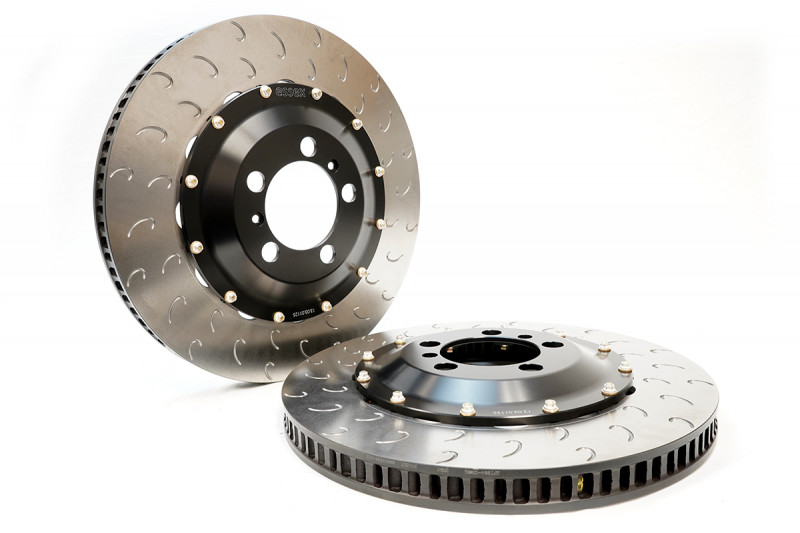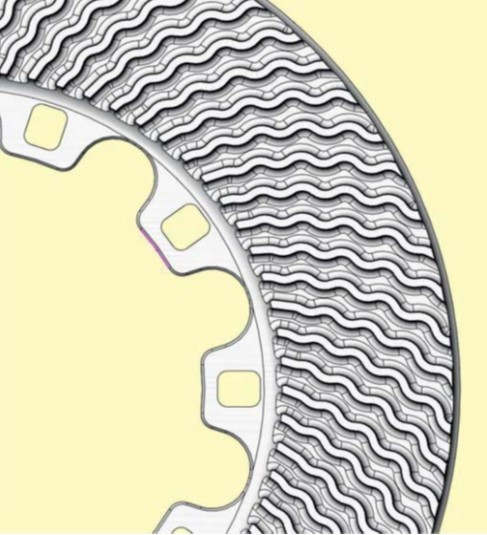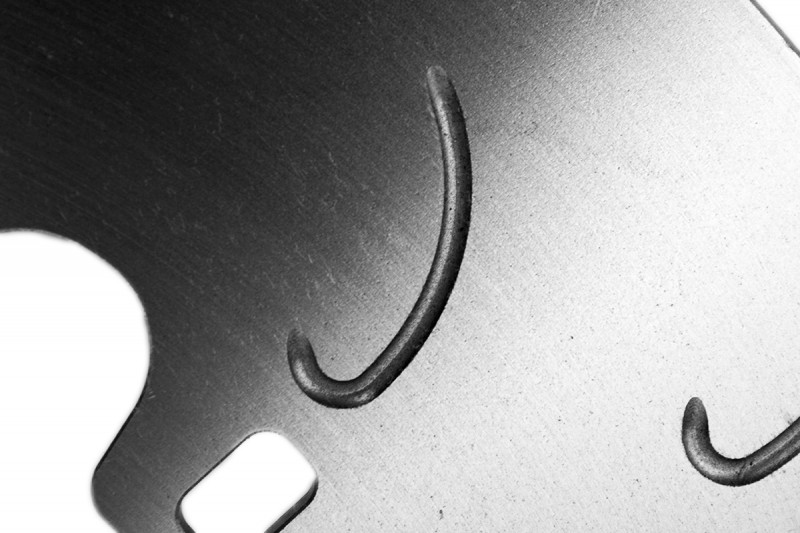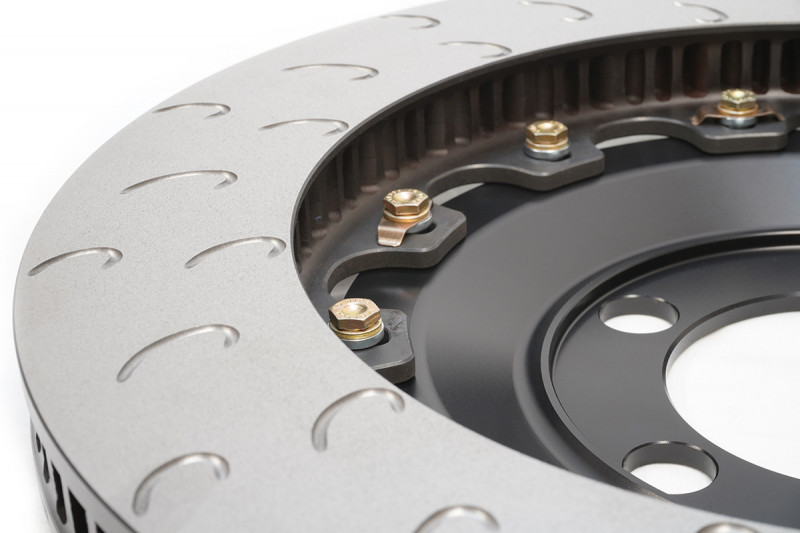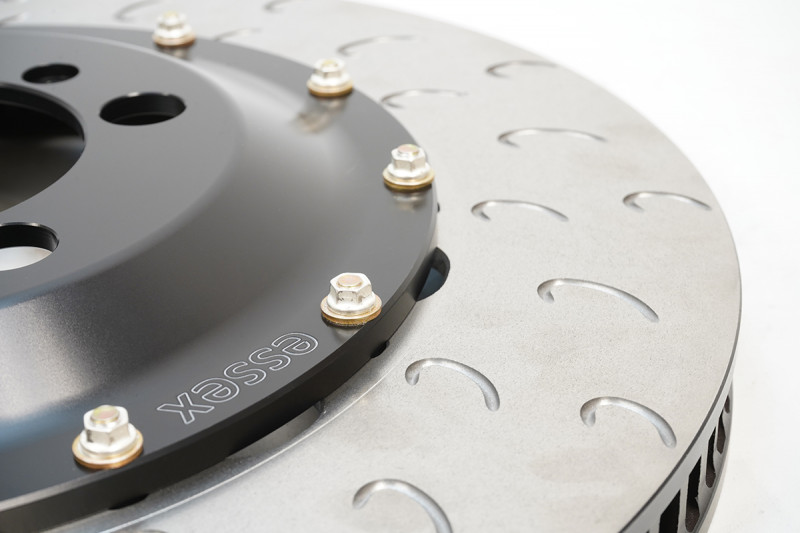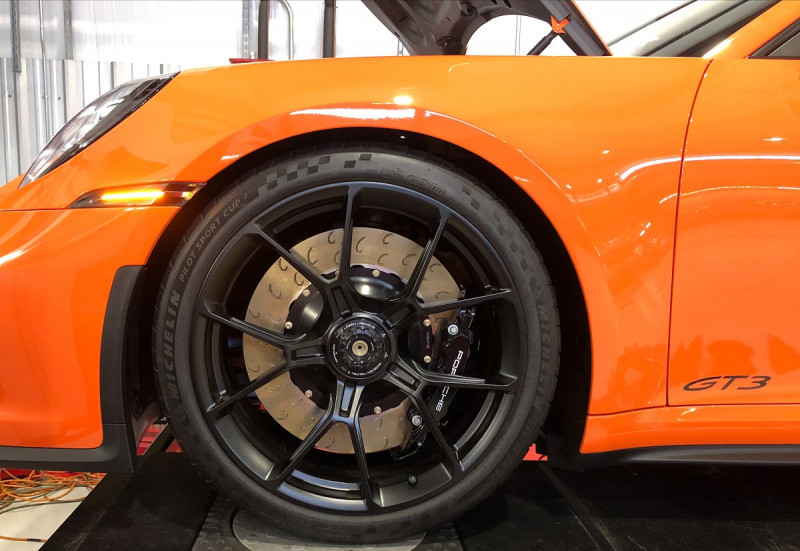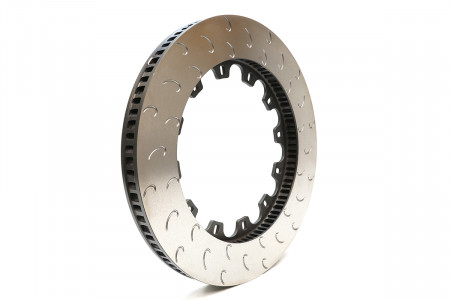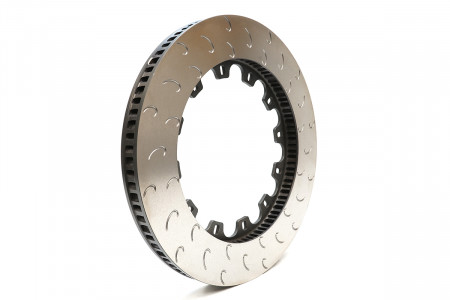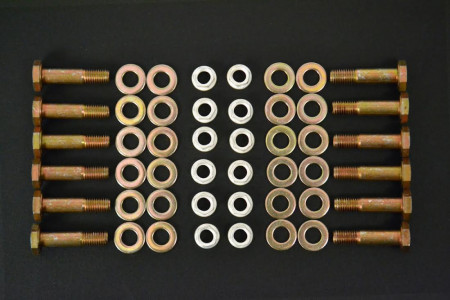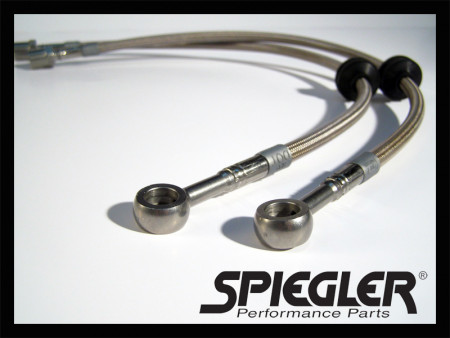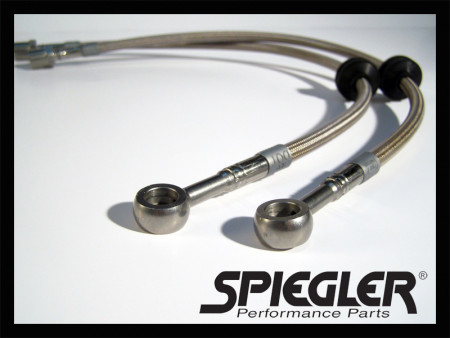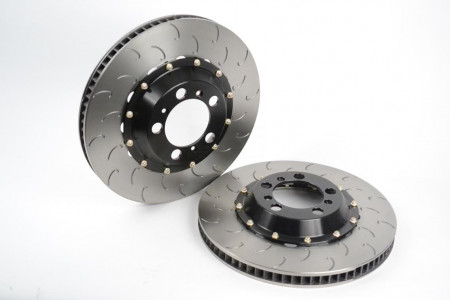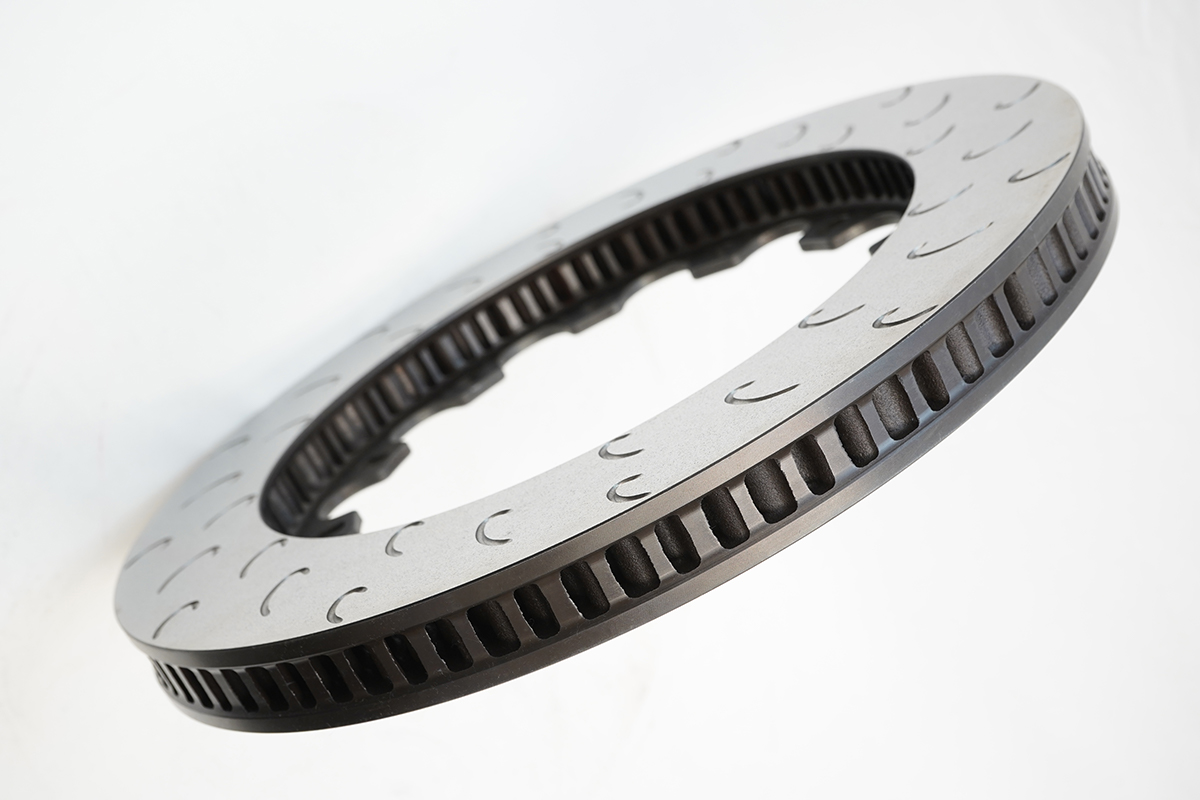- New Products
- Brake Caliper Stud Kits
- AP Racing Big Brake Kits
- AP Racing Brake Discs
- AP Racing Brake Calipers
- AP Racing Master Cylinders
- Essex Brake Bundles (upgraded pads, lines, fluid, discs that work with OEM Calipers)
- Brake Pads
- Brake Fluids
- Spiegler Brake Lines
- Tools, Temperature Indication and Protection Products
- Wheels
- Suspension
- Versodeck Flooring
- Apparel and Merchandise
- Formula SAE
- Clearance
AP Racing by Essex 2-piece S Vane Competition J Hook Disc Pair (Front 408x34mm)- Porsche 992 GT3, GT3 RS Iron & PCCB
Part #: 13.01.20038
Brand: Essex & AP Racing
AP Racing by Essex 2-piece S Vane Competition J Hook front disc pair for 992 GT3 and GT3 RS with iron or PCCB discs.
- ***Note for PCCB cars - must be used with the smaller D62 iron disc pad shape (Ferodo FCP4664 - DS3.12 / DS1.11 / DS2500)
- Massive increase in airflow, cooling capacity, and durability vs. OEM discs or even conventional curved vane discs
- 16.06" x 1.34" (408mm x 34mm), 84 Sinusoidal "wave" vanes, D62 radial depth
- Designed for: club racing, time trial, autocross, HPDE
- Works with OEM calipers, no modifications required
- Ultralight, fully floating, anodized billet aluminum hat with float control/anti-rattle clips
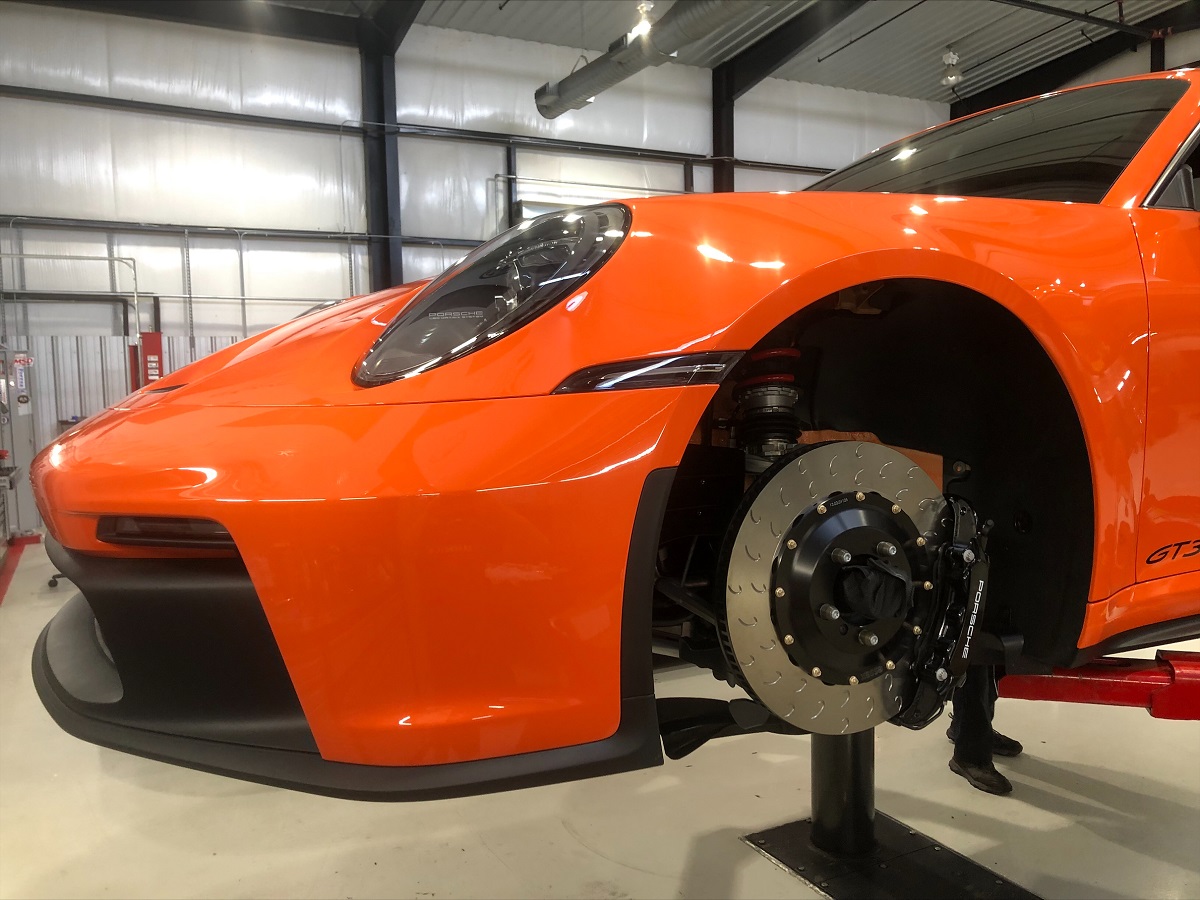
New AP Racing Sinusoidal "Wave" Vane Technology Makes its Production Car Debut on the 992 GT3
AP Racing J Hook Discs are the epitome of endurance racing components. They will hold up extremely well to any abuse you plan to throw at them. These discs have been proven time and again in professional racing, winning many races and championships (ALMS, Rolex, Grand Am, etc.). On the front 2-piece discs for the 992 GT3, we are introducing a new internal vane technology from our motorsports experience. It is called the Sinusoidal Vane, which AP sometimes refers to internally as the 'Wave' Vane for obvious reasons as you’ll see below. This tech is something that has helped AP Racing brake systems win championships in international GT racing, as well as multiple NASCAR Cup championships here in North America. As one of the most desirable track weapons on the planet, we wanted the 992 GT3 to be the first production car application for this technology in North America. Just as AP Racing's Radi-CAL calipers set a new benchmark for caliper stability, cooling, and durability, the Sinusoidal Vanes have done the same for iron racing discs.
The concept for this disc design originated in NASCAR Cup. Up until the debut of the Next Gen car (for which AP/Essex are supplying the spec brake package), we were cramming our brake systems inside tiny 15” wheels. Trying to squeeze adequate brake thermal mass into a wheel that small is incredibly challenging, particularly when you have a 1,000 HP and 3,000 pounds mashing on them every few seconds from 200 mph…for hours on end! In a wheel that small, there isn’t anywhere for the heat to go, and the durability of every component is crucial. We were constantly looking for ways to provide the Cup teams with increased durability, stability, and cooling, and that’s what led AP to this technology.
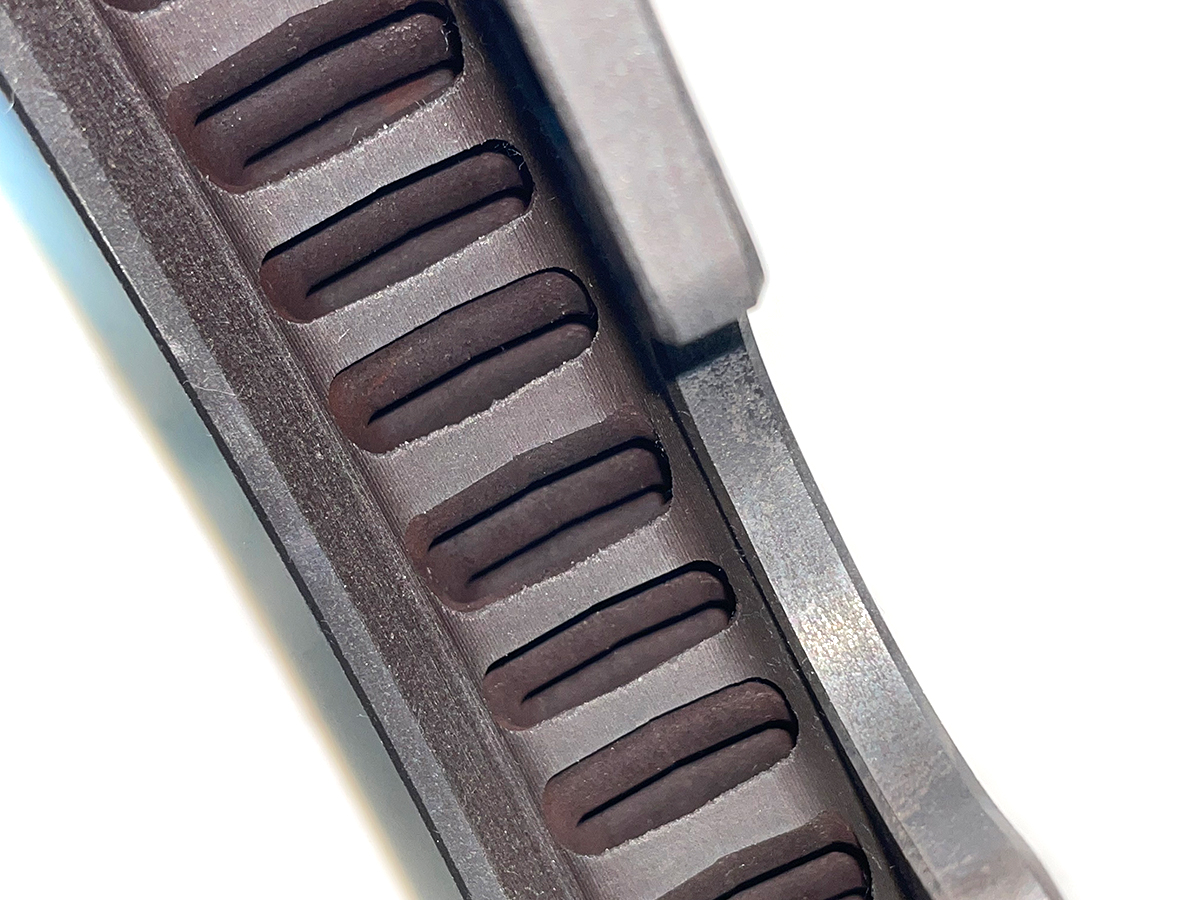
Benefits of the Wave Vane disc technology vs. traditional curved vanes:
- Increased thermal stability- Wild temperature swings are what causes discs to crack. When you stand on the brakes for an approaching corner, your disc temperatures skyrocket and the iron expands. As you travel down the subsequent straight, the discs are blasted with cooling air. The longer the straight and the higher the speed, the greater the temperature drop, and the further the iron contracts. This expansion and contraction cycle places a huge amount of stress on the iron and is what causes them to eventually crack. That’s why tracks with relatively slow corners at the end of high-speed straights, followed by another long straight, decimate brake discs (think Watkins Glen or Road America). In an ideal world, once you brought your discs up to race temps, you would keep them at a constant temperature for the entire session. The Sinusoidal Vane brings the discs closer to that goal by decreasing the difference between the maximum and minimum disc temperature by as much as 35%. That means a less dramatic temperature swing and greater crack resistance and durability.
- Reduced maximum disc temperatures by 10%+: Not only are temperature swings less intense with the Wave Vane, the maximum temperatures reached are substantially lower. For example, in one NASCAR test the Wave Vane discs showed a peak temp of 1328F and a minimum temp of 1085F (delta of 243F), while the traditional curved vanes maxed out at 1490F and a min of 1121F (delta of 369F). Not only was the difference between min and max more subdued, the max temperature reached by the Wave Vane disc was 162F lower!
- Increased cooling surface area- Each of the internal Wave Vanes has a larger cooling surface area vs. a traditional curved vane.
- Greater support for the disc face- A disc’s internal vane structure provides the support lattice behind the disc face. Having many internal vanes impacts airspeed and heat transfer through the disc, reduces air re-circulation between vanes, and reduces deflection at the disc face. In practical terms, a disc with a high number of vanes is more thermally stable, maintains more even contact with the brake pads (which reduces uneven pad deposits/judder), and is less prone to distortion. In summary, the Wave Vane design provides even greater support for the disc face than AP’s standard curved vane designs.
- Reduced weight- The Wave Vane design provides a slight unsprung weight reduction vs. a similar disc with curved internal vanes.
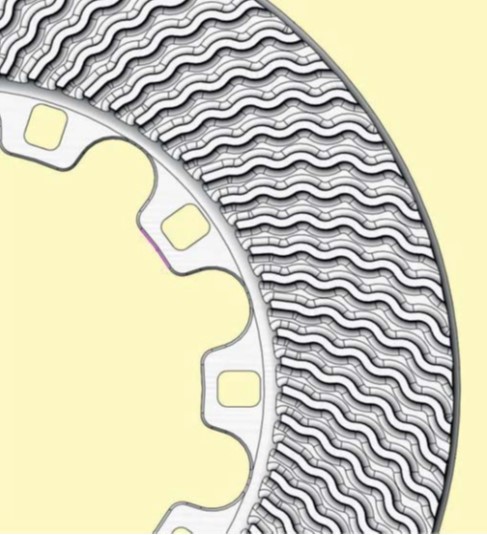
AP's new Wave Vanes above vs. traditional curved vanes inside a typical J Hook disc below:
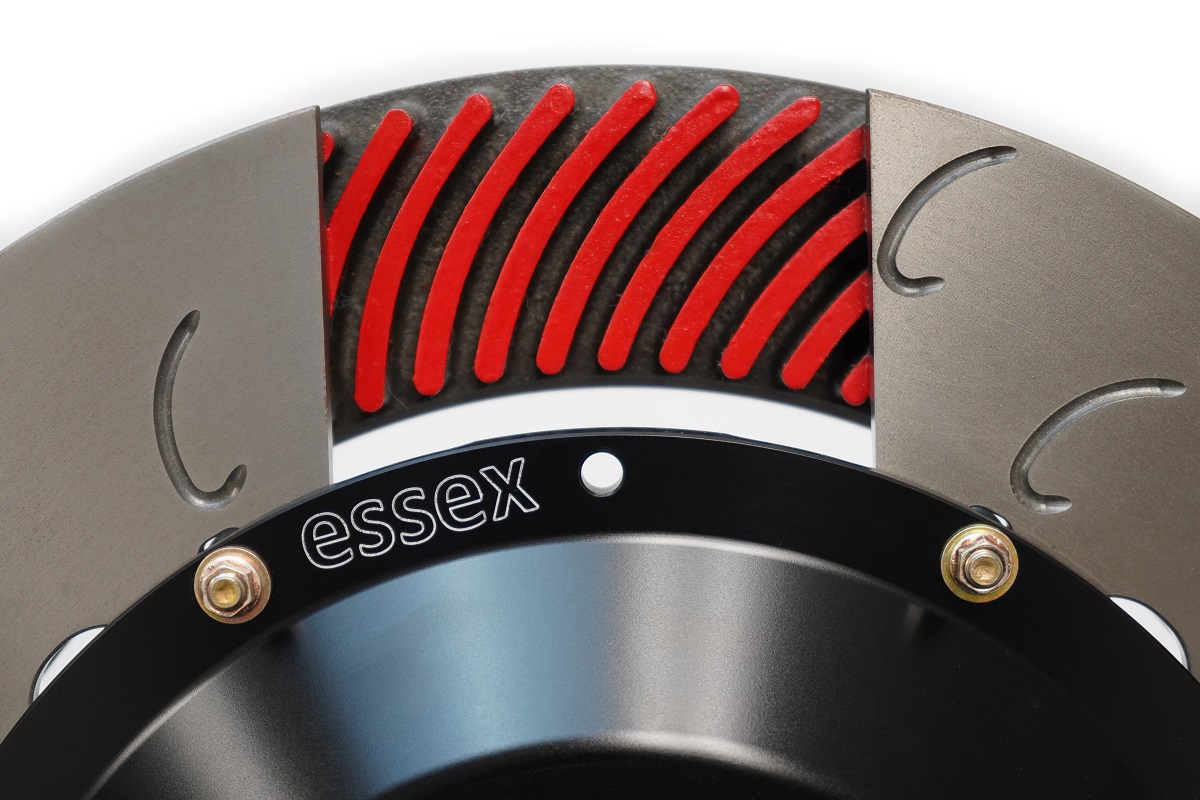
Two-piece Floating Design with Aluminum Hat
As is the case with most metal, iron brake discs grow substantially when heated. As it is heated, a disc expands radially, increasing in diameter and circumference. One-piece disc designs run into problems when this occurs. Look at the picture below and imagine the disc is being heated on the track. As the disc expands, the outer edges of the disc are pulling away from the center of the disc, but there are no built-in provisions to allow for that expansion. The edges of the disc therefore pull, lift, and distort, which is called coning. Now imagine that disc vertical on the car, running in your caliper. Coning directly impacts the brake pads’ contact with the disc, leading to uneven wear and tapering, and even a long brake pedal.
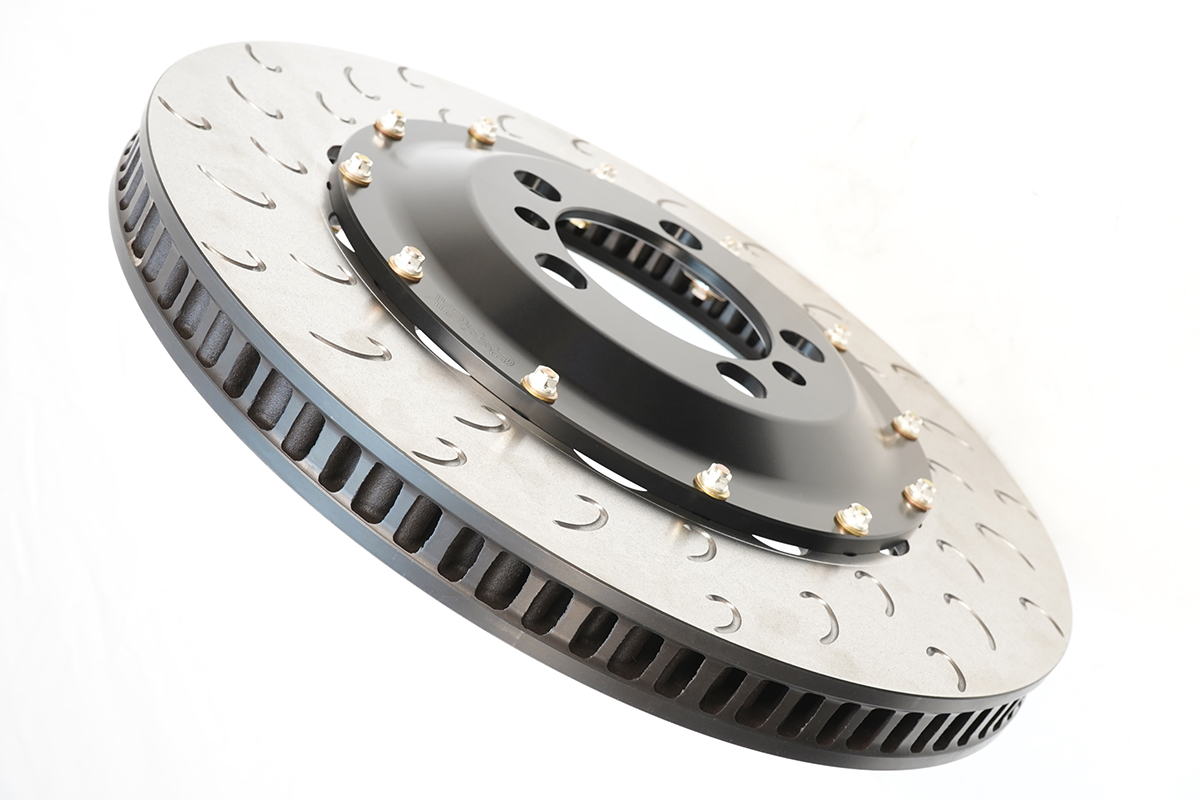
Two-piece discs on the other hand, compensate for the expansion of the disc as it heats. This is accomplished by building ‘float’ into either the disc itself, or the disc hat/bell. In this case, the float is in the disc. If you look closely at the picture below, you can see that the mounting holes for the hat attachment bobbins are not round. They are an oblong shape. These channels allow the hat mounting hardware to slide as the disc is heated and expands, allowing the disc to run true in the caliper without distortion. That means less distortion, stress cracks, and pad taper.
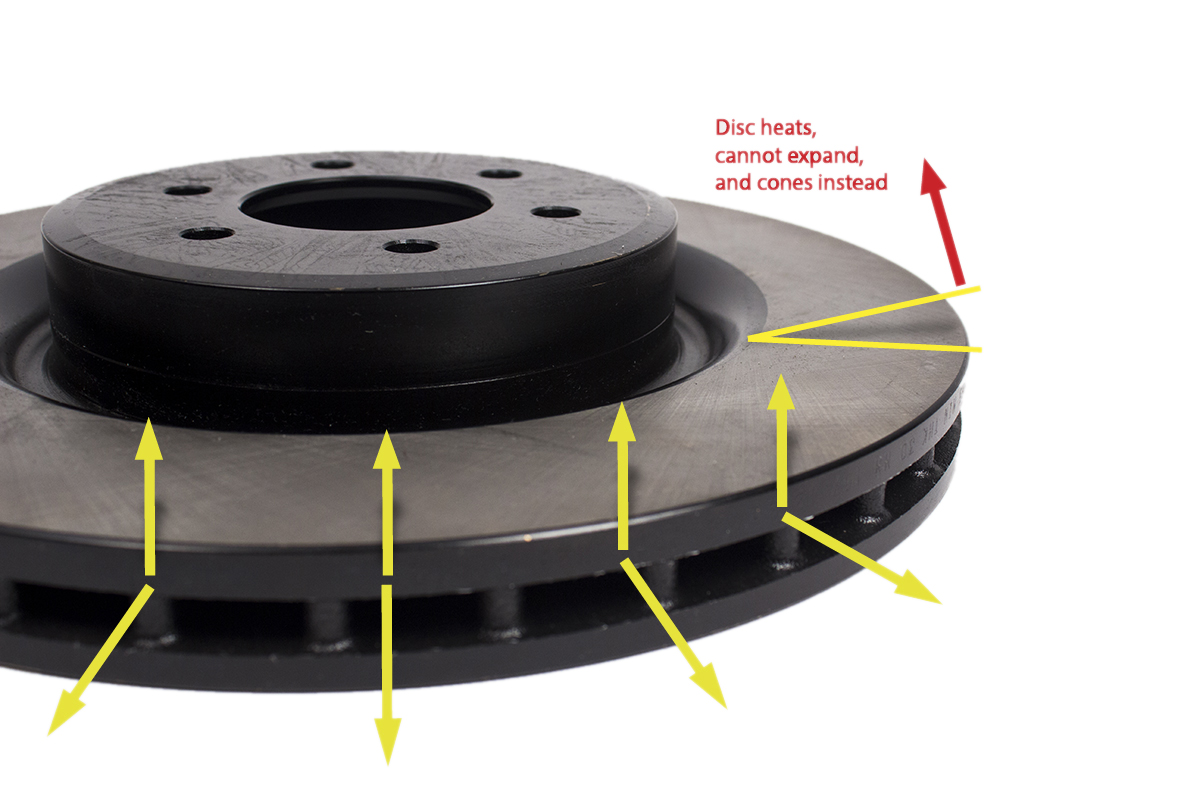
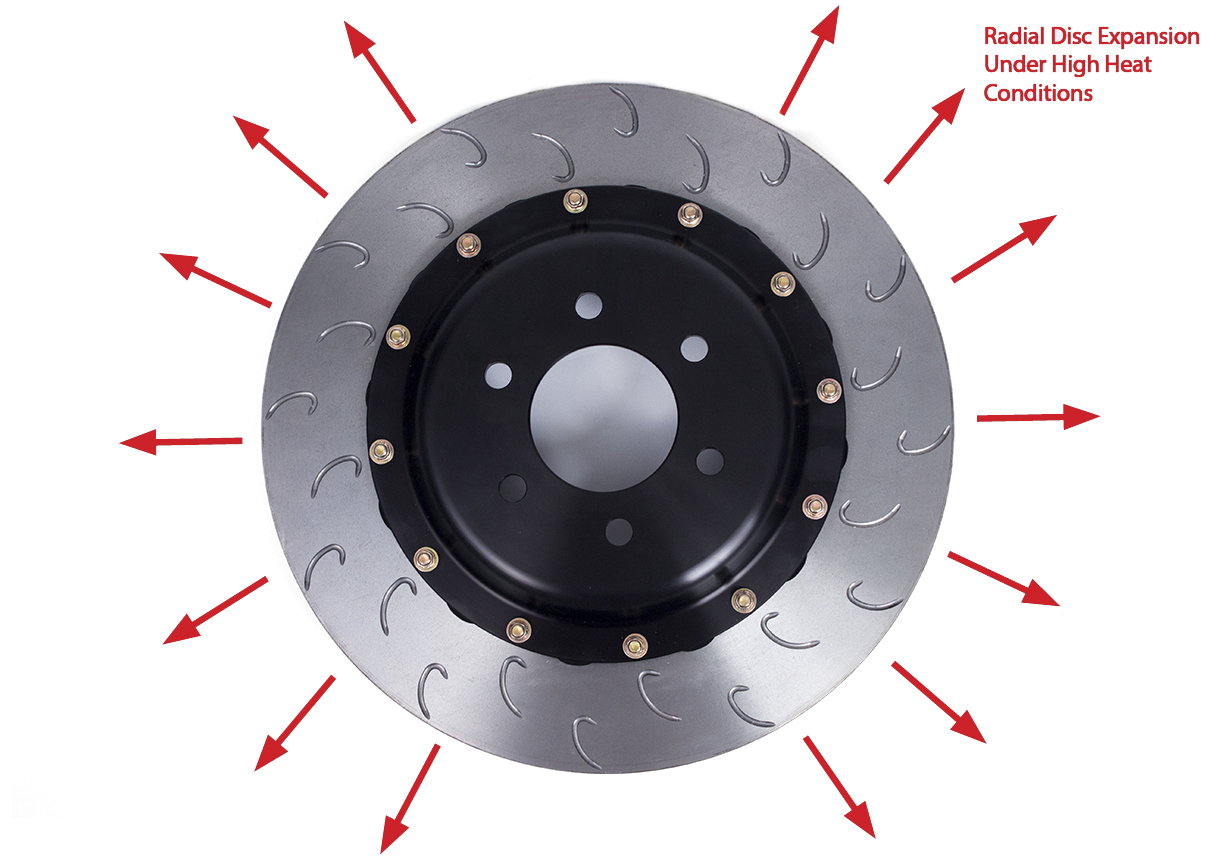
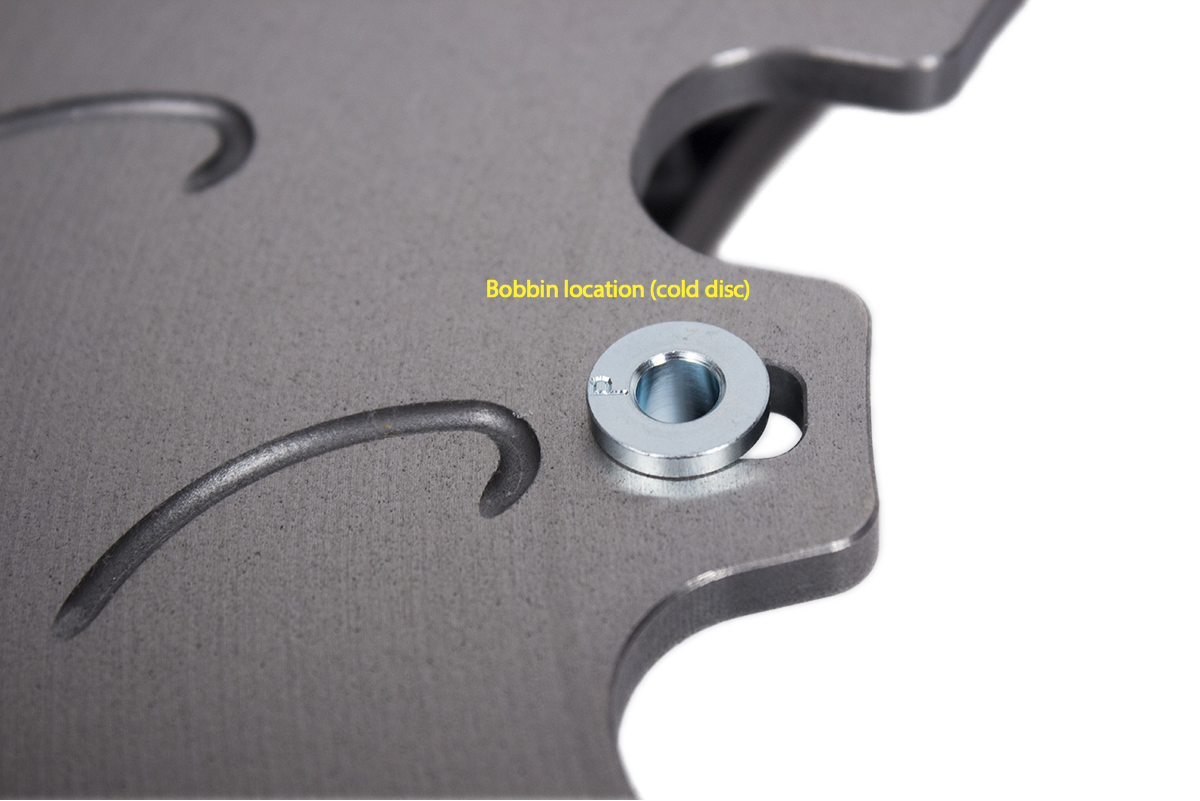
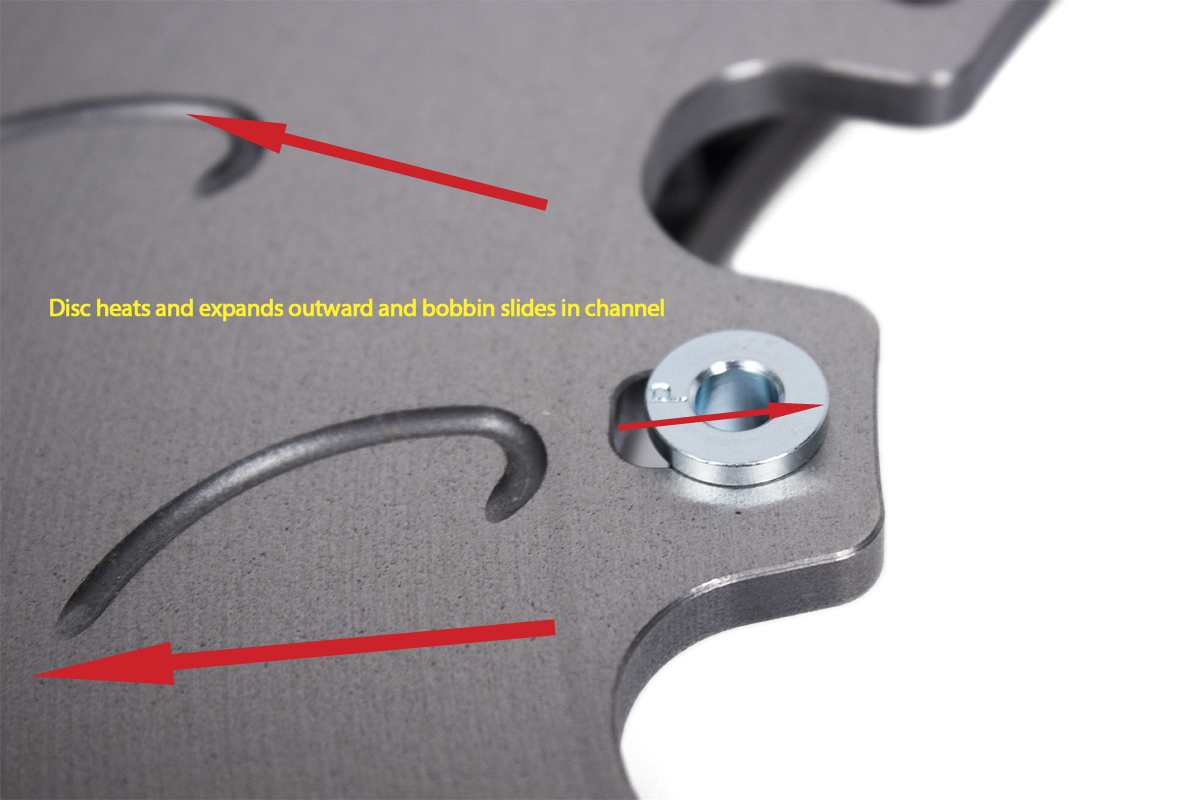
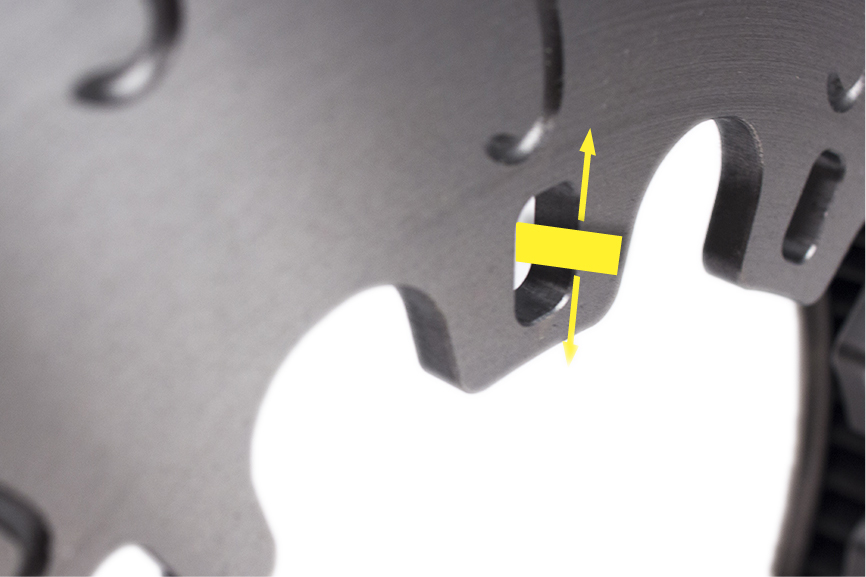
Mounting Hardware and Anti-Knockback Spring Clips
If you look closely at the mounting hardware we use on our Competition Discs, you’ll notice a few details that are often overlooked in lesser products. These components are specially made for their intended purpose. These are not cheap bolts found at your local big box store. They are custom made in the USA for Essex and AP Racing, and they are the exact same components we use on professional racing products.
In order to help control the lateral motion of the disc, which pushes the pistons back into the caliper, we use an anti-knockback spring clip on every other disc attachment point (on a ten bolt disc there are five spring clips, while on a twelve bolt disc there are six). These spring clips help keep the disc hat and iron ring in alignment, while still allowing the disc to expand and float radially. As an added bonus, they prevent the hat and iron disc from rattling and making noise.
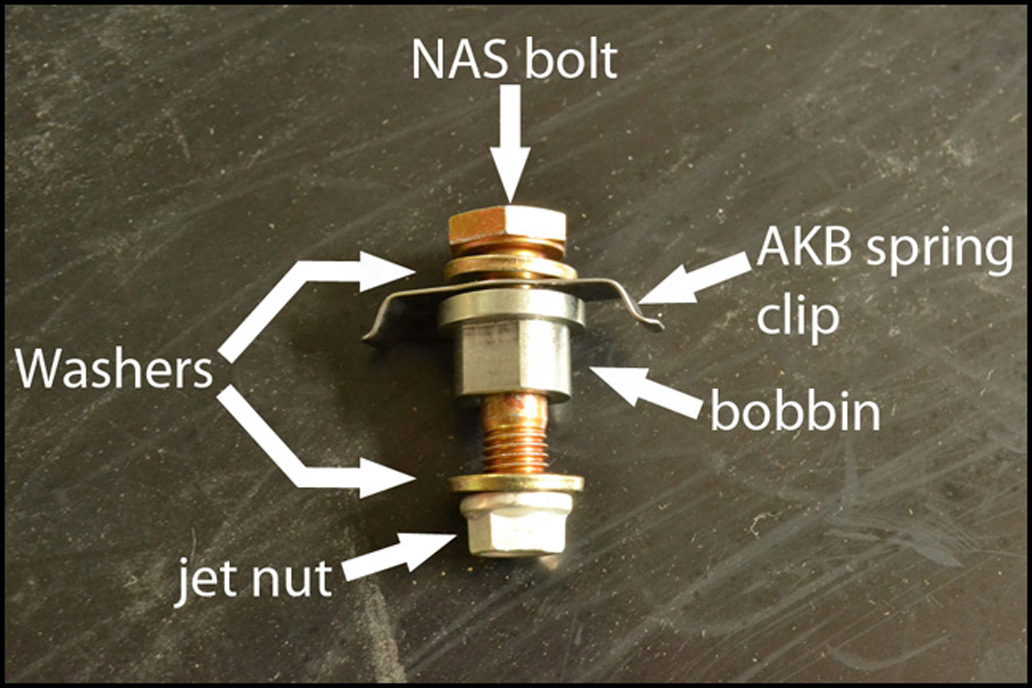
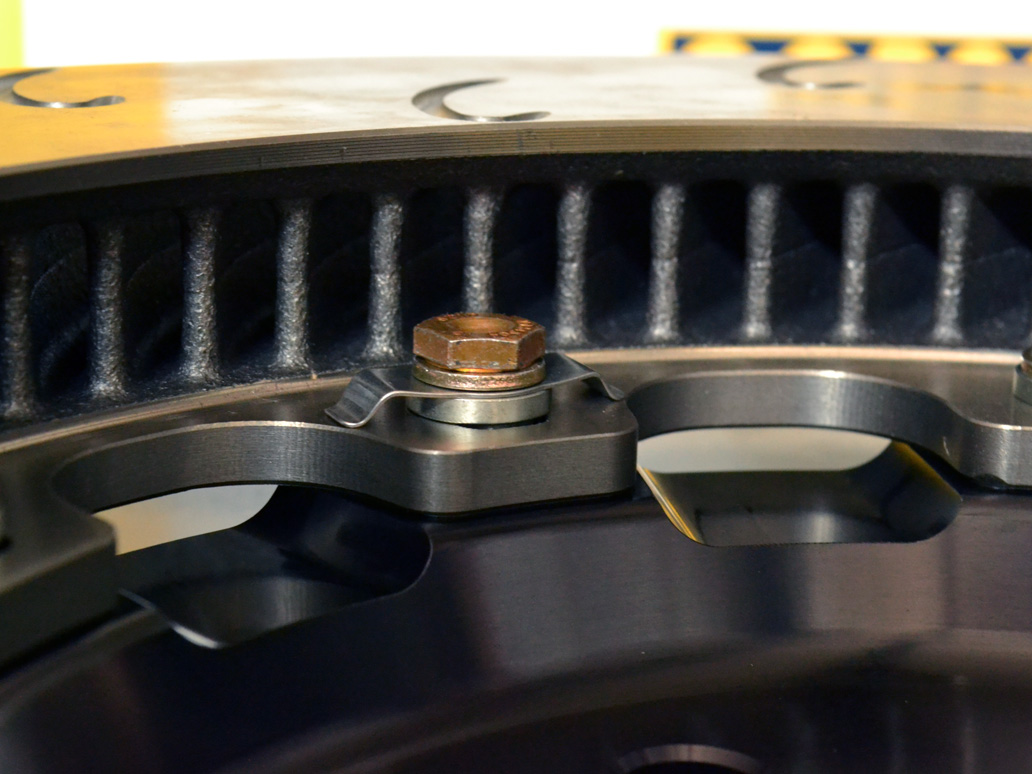
Hat Design
Floating two-piece discs also have the added benefit of reducing heat conduction to the hubs and bearings, decreasing wear and tear on these costly components. The disc hats themselves are manufactured from 6061 heat-treated billet aluminum, with a hard anodized coating. This material was specifically chosen for its strength at high temperatures, as it will be in direct contact with the searing hot iron discs. The hats feature scallops on the underside, to allow for heat evacuation along the outer disc face once installed.
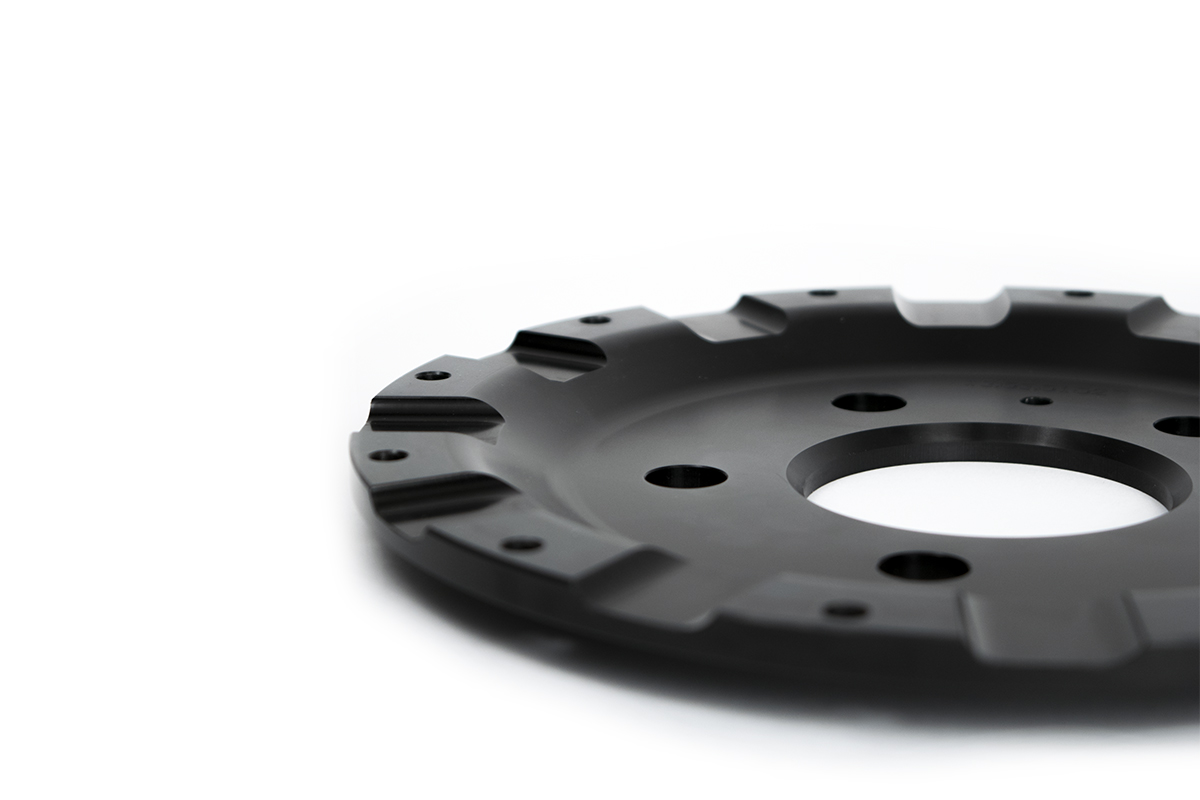
Exclusive AP Racing J Hook Slot Pattern
When you cut a slot or drill a hole in a disc you impact heat transfer. The area around the slot or hole acts as a cool spot when the disc heats up, which is not ideal. Ideally, heat is distributed uniformly around the disc so it can be hit with the cooling air that is pumping through the disc, radiate outwards away from the disc, etc. Cool spots create stress risers and increase the likelihood of the disc cracking. They also cause the face of the disc to distort unevenly, leading to uneven pad deposits, vibration, and judder.
The OEM discs avoid this
problem by simply leaving the face blank. While the risk for NVH goes
down, so does the pad bite and feel of the disc through the brake
pedal. Competitive aftermarket offerings typically have straight slots,
which tend to leave cool spots across the disc face between the slots.
During
exhaustive R&D testing, AP's J Hook design was found to create a
constant pathway of evenly distorted material on the face of the disc.
The hooks are spaced out as evenly as possible both around the
circumference of the disc, as well as from the inside edge (where the
hat attaches) to outer edge, with a slight overlap to promote even heat
distribution/distortion. In addition to reducing cracking, the even
heating of the disc also helps provide an even transfer layer of pad
material on the disc when you bed them in.
Additionally, the J
Hook slot pattern produces a greater number of leading edges for the
pads to bite into vs. a traditional curved slot pattern, and
particularly a plain-faced disc. While this may lead to slightly more
whirring or scraping noises from the discs when applying the brakes, the
benefits of more even heat distribution, less propensity to crack,
cleaner pad material transfer during bed-in, and more bite far outweigh
the slight increase in NVH for the serious enthusiast.
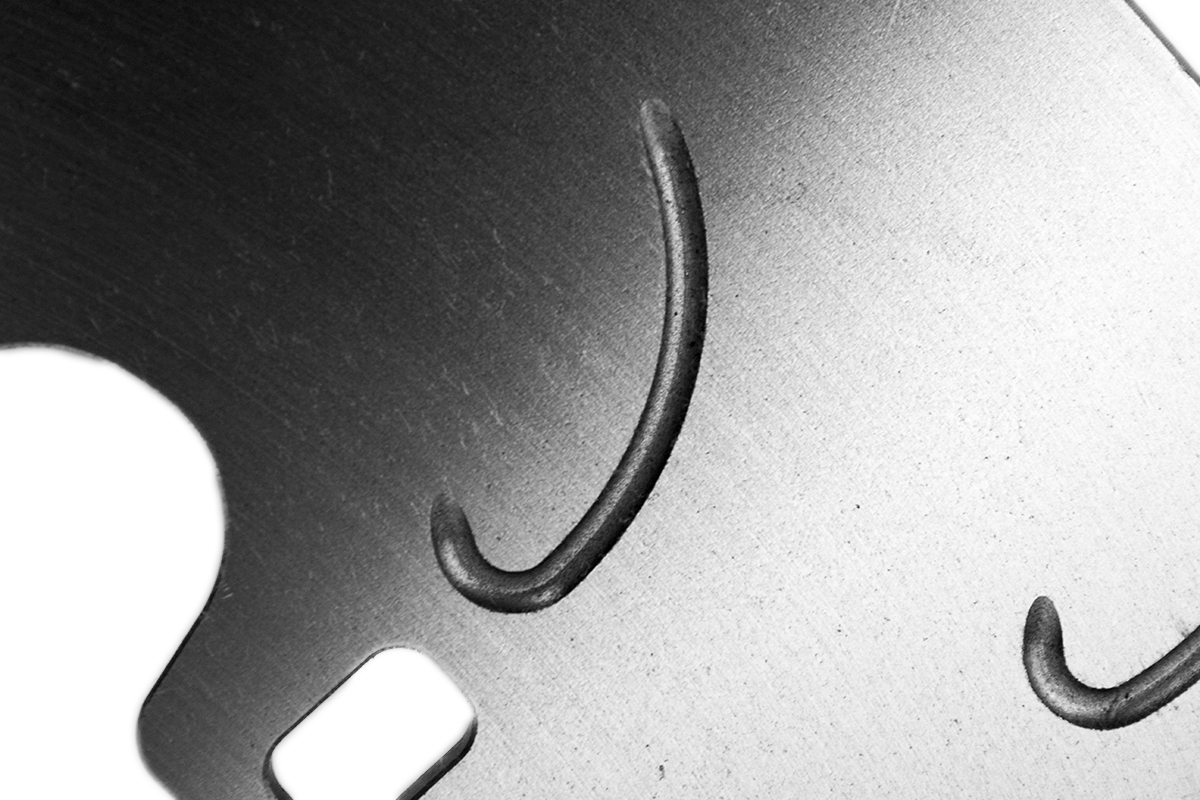
Feature: Complex Metallurgy Developed Through 50+ Years of Experience
AP Racing has been designing brake components for more than 50 years. They've had their components on cars that have won more than 750 Formula 1 races! On any given race weekend, AP J Hook discs can be found on 75% or more of the NASCAR Sprint Cup grid. AP has learned from these experiences, and have developed a proprietary iron alloy with extreme durability, designed specifically for what you intend to do with it (flog the hell out of it). The primary objectives with OEM discs are simple: they must be cheap and easy to produce. The design objectives for these two products are vastly different.
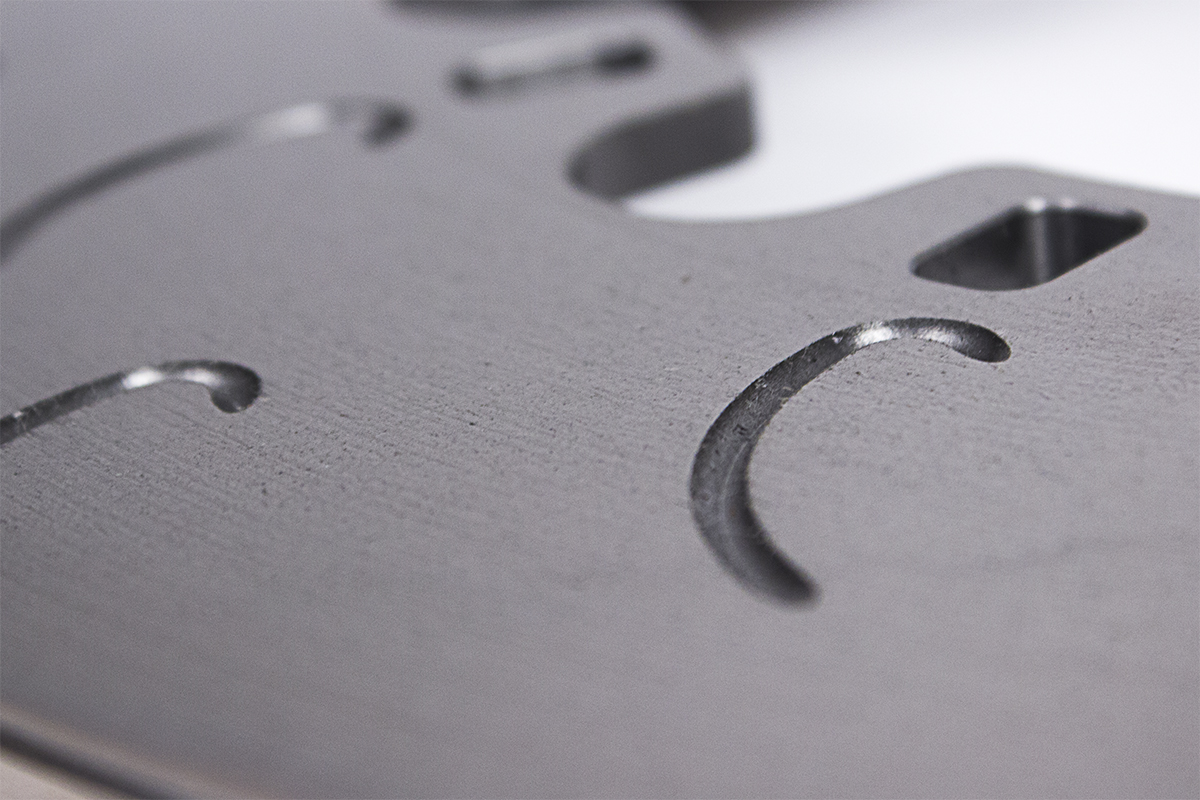
Disc Burnishing/Bedding Service
If your brake discs aren’t being properly prepared for abuse prior to flogging them on track, you’re exposing yourself to potential judder, vibration, and cracking issues. We all know that prepping your pads and discs at the track can be difficult. Doing so wastes time during the first session of the day, and it's a hassle and potentially dangerous for other drivers as you go through the procedure. Track time is expensive and tough to come by. The more time you spend behind the wheel performing an elaborate bed-in procedure, the less time you’ll spend doing hot laps. Performing the procedure on-track also limits its repeatability. You can't control what's going on around you with track conditions, other drivers, etc., and many track configurations don't really lend themselves to the constant start/stop/start required to do the job properly.
Essex is now offering a solution via our professional burnishing service. Previously reserved for our professional racing customers, we are now offering our retail customers the option of having the discs in select Competition Brake Kits pre-burnished at our factory. We burnish thousands of discs for the top racing teams each year. After countless hours of experimentation, and extensive feedback from the top drivers and teams, we can consistently squeeze the most reliable performance out of AP Racing's discs. The procedure is incredibly repeatable, as it is performed on a computer-controlled machine by experienced technicians.
The cost of our burnishing service is only $50 per disc, making it an affordable, time-saving option that will produce far more consistent and safer results than trying the procedure on your own.
Watch a brief video of our disc burnishing service here.
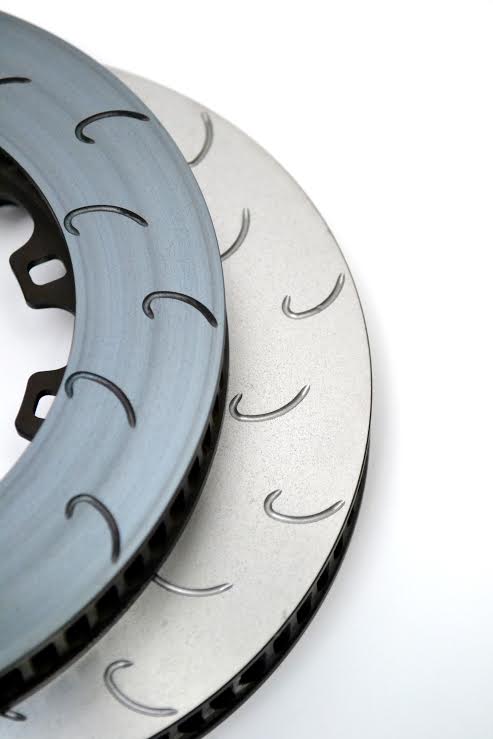
Reasonable Replacement Cost
Let's face it, no matter how good a brake disc is, it's still a consumable item. They're no different than brake pads or gasoline. You beat them up until they crack to pieces, then you throw them away. If replacement iron is too expensive, you're always driving in fear, waiting to shell out big bucks for a new set. Despite having the most expansive set of features on the market, our replacement iron rings are completely affordable.
Going to the track is expensive! Event entrance fees, hotels, fuel, and tires all add up. While you obviously want the best product available, you can't afford to pay a small fortune for something you're just going to destroy. You can buy a cheap set of $150 discs for every event, have relentless heat issues, and find yourself constantly swapping them out. When you do the math, the long-term value of the AP J Hook's is tough to beat. You'll enjoy all the benefits without breaking the bank, and you'll spend more time driving and less time wrenching.
Elite level teams choose AP Racing discs because they know the work has been done to provide the best available product at any price level. The AP J Hook is a direct derivative of AP's vast racing experience. You can buy with confidence knowing that you're getting the best product available at any price point. A note of caution however: the J Hook design is often imitated, and there are a number of lesser quality imitations on market. Before purchasing, make sure you are getting an authentic AP Racing J Hook.
Advantages Over OEM Brake System
Our AP Racing by Essex 2-piece Wave Vane Competition J Hooks offer our customers the following advantages over the OEM front 992 GT3 discs:
- Massive increase in airflow, cooling capacity, and durability vs. OEM discs or even conventional curved vane discs
- 16.06" x 1.34" (408mm x 34mm), 84 Sinusoidal "wave" vanes, D62
- Eliminates OEM drilled discs, which are prone to cracking around the drilled holes
- Designed for: club racing, time trial, autocross, HPDE
- Works with OEM calipers, no modifications required
- Ultralight, fully floating, anodized billet aluminum hat with float control/anti-rattle clips
- Available disc burnishing service ensures that your kit arrives ready to be installed and driven hard immediately
| Model Year | 2021+ | |
| Essex/AP BBK | | |
| Disc | OEM 992 GT3 Iron | |
| Type | 2-piece floating | Dual-cast |
| Weight | 26.2 lbs. | 25.9 lbs. |
| Diameter | 408mm | 408mm |
| Thickness | 34mm | 34mm |
| Radial Depth | 62mm | 66mm |
| No. of Vanes | 84 | 30 split, 30 solid |
If your brake discs aren’t being properly prepared for abuse prior to flogging them on track, you’re exposing yourself to potential judder, vibration, and cracking issues. We all know that prepping your pads and discs at the track can be difficult. Doing so wastes time during the first session of the day, and it's a hassle and potentially dangerous for other drivers as you go through the procedure. Track time is expensive and tough to come by. The more time you spend behind the wheel performing an elaborate bed-in procedure, the less time you’ll spend doing hot laps. Performing the procedure on-track also limits its repeatability. You can't control what's going on around you with track conditions, other drivers, etc., and many track configurations don't really lend themselves to the constant start/stop/start required to do the job properly.
Essex is now offering a solution via our professional burnishing service. Previously reserved for our professional racing customers, we are now offering our retail customers the option of having the discs in select Competition Brake Kits pre-burnished at our factory. We burnish thousands of discs for the top racing teams each year. After countless hours of experimentation, and extensive feedback from the top drivers and teams, we can consistently squeeze the most reliable performance out of AP Racing's discs. The procedure is incredibly repeatable, as it is performed on a computer-controlled machine by experienced technicians. The cost of our burnishing service is $50 per disc ($100 per brake kit).
Please note that the pads you receive will not be pre-burnished. In other words, the pads and discs do not have to be a matched set burnished together to reap the benefits the procedure has on the discs. In other words, we will burnish the discs in the pad compound you choose, they just won't be burnished with the exact set of pads that will arrive with your kit.
If you'd rather have a go at preparing your discs yourself, please watch the video below:
Spare Iron Brake Disc Rings
This kit uses the following iron disc part #'s:
Right Hand Replacement Iron Disc Ring - 13.05.10082 / CP7384-128GC
Left Hand Replacement Iron Disc Ring - 13.05.10083 / CP7384-129GC
Disc Attachment Hardware
12-bolt disc attachment hardware kit (enough for one disc)
Competition J Hook Disc FAQ
Q: Where can I buy your discs?
A: Essex sells directly to both retail customers and through an extensive network of wholesale dealers/resellers across North America.You can check our Dealer Locator tool to find a local reseller.The other option is to place an order directly on our website, or call us to place an order by phone.
Q: Do you have a brake pad that works well with these discs on both the street and the track?
A: No such pad exists.There will always be a compromise when running a pad in an environment for which it was not specifically designed.See the two questions below for more details.
Q: Is it okay to run street pads on the racetrack?
A: No! Street pads are designed to chase groceries, not lap times.If you overheat a street pad beyond its max operating temperature, you risk not only destroying those pads, but your discs as well.Essex always recommends using street pads on the street, and race/track pads on the track.Please see "How to Choose the Best Street and Track Brake Pads" for a more detailed explanation and guidance on pad choice.
Q: Is it okay to run race pads on the street?
A: Most race pads are designed to work optimally at high temperatures.As such, they many times don't have good cold bite, making them a poor choice for street use.Even if they do have cold bite, they will likely make a lot of squealing and screeching noises, produce heavy dust, and chew your discs up in a hurry when driven around cold.Please see "How to Choose the Best Street and Track Brake Pads" for a more detailed explanation and guidance on pad choice.
Q: Do I have to modify my car to install your discs?
A: In almost all cases, no.If not otherwise noted, the discs will drop onto the car without any required modifications.On a few of our disc kits caliper spacers and longer caliper bolts are needed.For those applications, we include the spacers and bolts.Again though, unless otherwise noted, the discs will bolt onto the car without doing anything else.
Q: Will your discs significantly shorten my stopping distances with all else held equal?
A: No! Tires stop your car.Brakes turn the energy of the spinning brake discs into heat.The primary function of a properly designed big brake kit to withstand the heat encountered during the repetitive and heavy use of the brakes.Anyone who sells you a brake kit specifically to shorten your stopping distances is lying to you.If you want shorter stopping distances, buy stickier tires. If you want your brakes to feel exactly the same on the last lap of the day as they did on the first lap, buy our brake discs.
Q: I saw that your discs reduce unsprung weight…will that help me?
A: Yes! Reducing unsprung weight not only improves braking performance, but also translates to superior acceleration and cornering as well.As is the case with switching to a lighter wheel and tire combo, installing lighter brake components can improve your car's overall performance envelope.
Q: Are spare iron disc rings available and reasonably priced?
A: Being a company brimming with racers and track junkies, we're very aware of the costs of running a typical track event schedule for the year...event fees, gas, hotels, tires, etc. It all adds up quickly. When we created our Competition Disc product line, availability and long-term running costs were of paramount concern.We did a couple of things to address these issues.First we're buying loads of spares and keeping them on the shelf in our warehouse in Charlotte, NC.Buying in bulk also brings the cost down, so we can pass them along at prices that may surprise you for a premium European brand.When you look at the specification of our discs vs. the competition, AP's racing heritage, and the longevity you'll get from them, they are an incredible bargain.Most of the competitive discs on the market are 48 vanes or less, weigh more, have less optimized vane design, inferior metallurgy, and have never been proven under the same conditions as the AP Racing discs.Many of our race customers have run an entire season or more on a single set of discs.
Q: Which side of the vehicle is left, and which is right?
A: If you're sitting in the driver seat of a USDM vehicle, you are on the left side/driver side.The other side is the passenger side/right side.
Q: Which disc is the left hand disc, and which is the right?
A:To illustrate further:
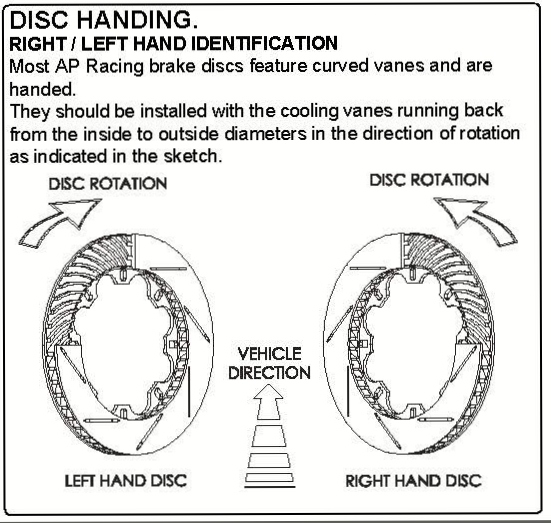
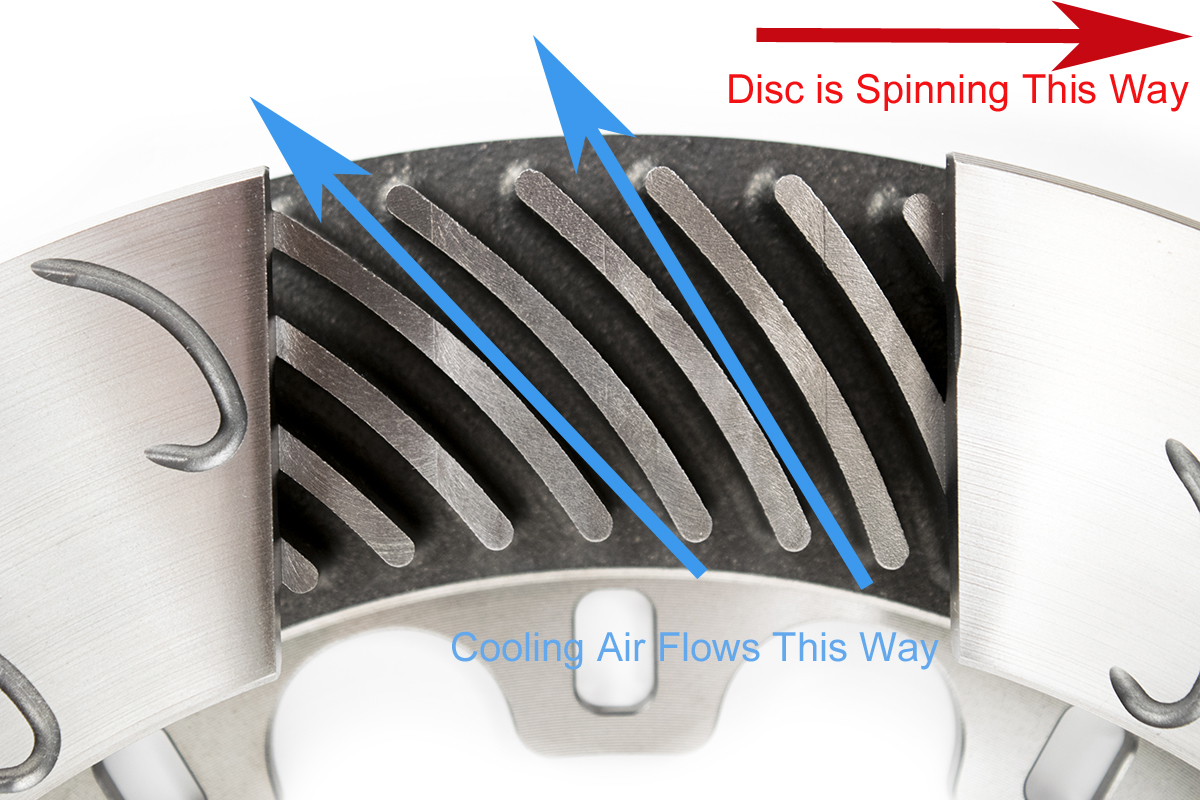
Q: How do I bed-in / burnish my new pads and discs?
A: We have a detailed video that goes into the burnishing procedure in great depth.Please see our video "How to Bed-in Brake Pads and Rotors."
Q: I have a vibration or judder when I press the brake pedal. How do I get rid of it?
A: What you are experiencing is most likely an uneven brake pad deposition on the disc face.What that means is brake pad material is stuck to the face of your brake disc in splotches and patches.On a properly bedded/burnished disc, that material is evenly distributed around the disc.If it is unevenly smeared on the disc, high spots are created on the disc face.Every time you press your brakes and the pads come in contact with that high spot, you feel it as a judder through the brake pedal and/or steering wheel.Our recommendation is to first try and remove those high spots by driving an aggressive set of race pads cold.When you drive race pads cold, they scrape material from the disc, rather than depositing material on the disc.In this manner you can "clean" your discs.To see this process in action, check out our video "Swapping Between Street and Race Brake Pads."
To help prevent uneven pad deposits in the future, never come to a complete stop and leave your foot on the brake pedal after heavy brake use (coming off the track).Also, do not engage your parking brake under those conditions
Q: Why do my brake discs feel slimy, and how do I clean this oil off of my brake discs?
A: The oil is to keep the discs from rusting while they are sitting in a warehouse and in transit.Washing them with soap and water will be sufficient to get them clean and prepped for install.
Q: Do I need to buy new discs, or machine my discs when I buy new pads?
A: No.As long as your discs are not below their designated minimum thickness, or cracked beyond use, you can run them with your new pads.Machining the discs is not required.That said, if you're switching to a different pad compound, it's usually a good idea to scrub your new discs first, to remove the old pad material from them.You can see details on this procedure in our video "Swapping Between Street and Race Brake Pads."
Q: My brakes squeal when I stop…what can I do?
A: One of the most common causes of brake squeal is poorly bedded discs.Please see our video "How to Bed-in Brake Pads and Rotors."
Q: I live in (country outside of North America).Can you ship me your brake discs?
A: Due to contractual obligations with AP Racing, Essex only ships to physical addresses inside North America, or to a territory in which there isn't currently an authorized AP Racing distributor.To see if there is an authorized AP distributor in your area, please click here.Your other option is to contact one of our current authorized dealers and see if they can help you.
Q: Do you offer discounts to internet forum members, or to members of clubs and organizations such as NASA, SCCA, PCA, BMWCCA, etc.?
A: Due to the narrowly targeted nature of our products, just about every customer of ours is in some way involved with one of these organizations.If we offered this type of discount, we'd essentially be discounting to every single customer.That is not a policy that would allow us to stay in business and keep bringing you the best brake products on the market for your car!
Also, since we sell to wholesale customers, we cannot undercut them on price.As such, all products we sell to retail customers are sold at the retail price listed on our website.
Q: Do you offer sponsorships?
A: AP Racing is frequently recognized as the #1 brake supplier in professional racing today.Top teams from around the world in F1, Sprint Cup, ALMS, WRC, etc. pay a premium for AP Racing brakes because they are the best brake products available at any price.To receive any type of consideration for a sponsorship, you would have to provide an extraordinary amount of media coverage, and bring tangible benefits to the AP Racing and Essex brands.
From time-to-time we do have retail customers test new products.In those cases we would offer a small discount for providing feedback on those products.
Q: What about driving with your discs in foul weather conditions?
A: We've had a few rally customers ask about foul-weather performance .Any aftermarket discs will require similar maintenance and present the same problems in foul weather conditions. The most vulnerable area for problems is the attachment point between the iron disc and aluminum hat. That's why you don't see a whole lot of OEM two-piece discs using an aluminum hat.Over the years many OEM's use a dual-cast iron design with as few moving parts as possible. What happens is, that road salt and other gunk gets wedged between the hat and iron disc ring, and it is essentially impossible to remove short of taking the disc apart. The salt eats away at the aluminum hat, eventually flaking, chipping, etc. Again, this is a problem that will be encountered on ANY aftermarket brake discs with an aluminum hat (FYI…the same sort of things happen with the caliper brackets on just about ANY aftermarket BBK. They're almost all anodized aluminum).
Our recommendation is that if you are going to be driving the discs in inclement weather, we recommend disassembling and thoroughly cleaning them with soap and water on a regular schedule.
Q: Are your brake discs road legal?
A: All of the brake products Essex sells are designed for off-road use only.If you read the fine print on any aftermarket big brake kit, from any manufacturer, you'll find the same thing...for off-road use only.We don't design our brake discs to meet any government standards, as there is no such standard or requirement in the USA for brake discs.There are however some regulations on brake hoses/lines and brake fluid.All stainless steel brake hoses and brake fluid that Essex sells are DOT compliant.Please read below and click the link for more details and info.
There are several federal organizations involved with the regulation of vehicle parts in the USA, but the two most relevant to the products we sell are the Department of Transportation (DOT) and the National Highway and Transportation Safety Administration (NHTSA).
NHTSA is the U.S. government agency responsible for implementing and enforcingthe National Traffic and Motor Vehicle Safety Act of 1966, as amended, 49 U.S.C. Chapter 301 (the Vehicle Safety Act),and certain other laws relating to motor vehicle safety. Under that authority, NHTSA issues and enforces federal motor vehicle safety standards (FMVSS) that establish minimum safety performance requirements for motor vehicles and for 13 items of motor vehicle equipment(i.e., “regulated motor vehicle parts”). Regulated motor vehicle parts include tires, rims, brake hoses, brake fluid, seat belt assemblies, lighting equipment, glazing, motorcycle helmets, child restraints, compressed natural gas containers, rear impact guards for trailers, platform lift systems for the mobility-impaired, and triangular reflective warning devices.
To be lawfully imported, a new or used regulated motor vehicle part must, as originally manufactured, conform to the version of the applicable FMVSS in effect on the date of manufacture and be so certified by its manufacturer.In most instances, certification of compliance with the applicable FMVSS for regulated motor vehicle parts is shown by the symbol “DOT” either inscribed on the part in a prescribed location, or placed on the outside of the container in which the part is shipped.The full text of each FMVSS for motor vehicles and motor vehicle equipment appears in49 CFR 571.Most of the standards listed below are vehicle standards. Compliance with a vehicle standard is certified by the vehicle manufacturer and not by the manufacturer of the vehicle system or component that is addressed by the standard. Some of the standards establish minimum safety performance requirements for motor vehicle equipment. Those standards are marked in the list below with an asterisk(*). The manufacturer of equipment that is subject to a standard must certify the equipment’s compliance with the standard.
You can see full details here:http://gsi.nist.gov/global/docs/motor_vehicle_part...
Can the manufacturer of my car deny a warranty claim because your brakes are on it?
The information below is provided by SEMA, and can be found on their website (www.sema.org) under “Federal Warranty Laws.” You can also Google “The Magnuson-Moss Warranty Act (15 U.S.C. 2302(C).”
The Magnuson-Moss Warranty Act is a federal law that regulates warranties to protect consumers.It essentially states that the use of an aftermarket part alone is not cause for denying the warranty. However, the law's protection does not extend to aftermarket parts in situations where such parts actually caused the damage being claimed under the warranty. Additionally, consumers are advised to be aware of any specific terms or conditions stated in the warranty, which may result in its being voided. The law states in the relevant section:
“No warrantor of a consumer product may condition his written or implied warranty of such product on the consumers using, in connection with such product, any article or service (other than article or service provided without charge under the terms of the warranty) which is identified by brand, trade or corporate name....” (15 U.S.C. 2302(C)).
Q: Do your brake discs come with a warranty?
A: No.The disclaimer of warranty below appears on the first page of the install manual inside the box of every Essex Designed Competition Disc Kit.That said, if you order discs and there is something blatantly wrong when you open the box (the wrong size of disc is inside, etc.), we will do everything in our power to correct the situation immediately.We have stringent quality controls in place to prevent such a situation from occurring, and in all cases, multiple employees handle and check our products for issues before they go out the door.
Disclaimer of Warranty
By purchasing this product and opening this box, purchaser expressly acknowledges, understands and agrees that they take, select and purchase this brake system, parts, and equipment from Essex Parts Services, Inc., its affiliates, suppliers, distributors, and agents (collectively, “Essex”) “as is” and “with all faults.” The entire risk as to the quality and performance of this brake system, parts, or equipment is with the purchaser. Should the goods prove defective following their purchase, the purchaser assumes the entire cost for all necessary servicing or repair or any resulting liability. Essex is not responsible for any damage, consequential or otherwise, for equipment failure or mal-performance after installation. Essex makes no warranties whatsoever, expressed or implied, oral or written, to purchasers or any users of these products. Essex expressly disclaims any implied warranty of merchantability or warranty of fitness for a particular purpose, including fitness of these systems, parts or equipment for racing or road use. No warranty or representation is made to the product’s ability to protect the user from injury or death. The user assumes all risk.By purchasing this product and opening this box, purchaser expressly affirms that they are relying upon their own skill and judgment in selecting and purchasing these goods as suitable for purchasers’ intended use. Purchaser understands and agrees that no officer, director, salesman, distributor, or agent of Essex has any authority to make any statement contrary to the terms of this disclaimer and agreement. On the contrary, Essex disavows any statement contrary to what is written above.
See these discs in action in our Customer Gallery.

